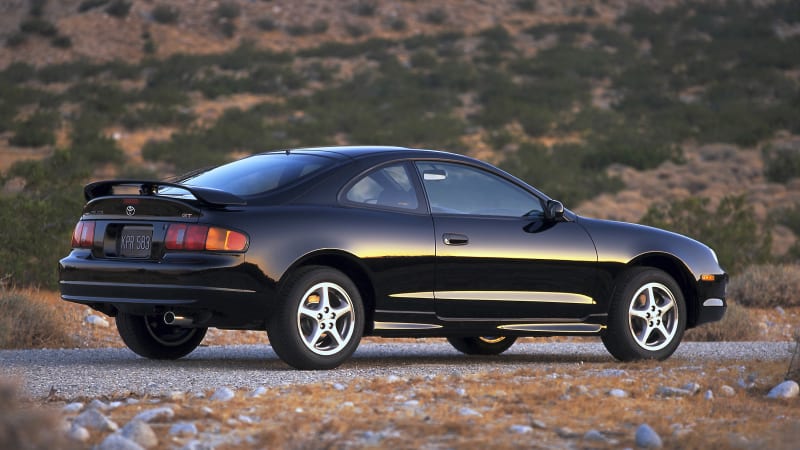Future Classic: 1994-1999 Toyota Celica

Today, Toyota is undergoing a sort of performance car rebirth. The automaker offers the GR86, GR Supra, and GR Corolla in the United States, an about-face from just a few years ago when the sportiest car it offered was a V6-powered Camry. Toyota also offered a trio of sports cars in the 1990s, with the Celica, MR2, and Supra. The Celica took a bow almost 20 years ago, but it remains a popular choice among Japanese car enthusiasts for its sporty styling and fun driving dynamics.
There were seven Celica generations, so which one is best? The sixth-generation cars bring great value and feature the car’s signature styling before Toyota went off the rails for the seventh and last generation. They are also old enough to be eligible for import now, opening the door to all the weird and wonderful Celica variants Toyota saved for other countries. Let’s get rolling to discuss why the sixth-generation Celica is a future classic.
Why is the Toyota Celica a future classic?
The Toyota Celica, in general, has been enjoying a growth in popularity over the last 20 years, and its star has shined even brighter as other models become increasingly expensive and hard to find. Sixth-generation cars are a sort of last of the old-type of Celica, as the seventh-generation car was the not-so-loved model from the early 2000s.
The 1994 model year marked the sixth-gen Celica’s first on the U.S. market, and the two available trims offered buyers a choice between a base ST trim and a sportier GT trim. The entry-level ST came with a 1.8-liter engine, while the GT got a larger 2.2-liter engine shared with the Camry. Though other countries continued getting the All-Trac all-wheel drive versions, Americans didn’t see a rally-ready Celica during this generation.
Toyota also offered a convertible version, which was converted after production from the GT coupe. Toyota shipped the cars to California as partially assembled cars, and then ASC finished them by removing the roof and installing a three-layer powered soft top.
While the Celica name continued on for a few years after it, the sixth generation was the last car that remained true to the original styling and design languages. The seventh-gen car was sharper and eventually fell victim to declining sales. Sixth-generation cars are also eligible for import to the U.S., so buyers can get more powerful and obscure versions of the car from Japan and other countries.
What is the ideal example of the sixth-gen Celica?
If you’re shopping for American-market Celicas, the best sixth-generation examples come from 1996. It was the last year before Toyota started shuffling trims and models as the generation aged. The model year also brought a facelift and some new features for some configurations of the car. The 1998 and 1999 model years are runners-up because they were the last two in the sixth-generation’s lifecycle. Toyota reduced the number of variants offered in the last year, but buyers could still get the more desirable GT model.

If you’re in the mood to import a car or buy an already-imported Celica, there are several great years. Toyota offered a GT-Four version in Japan for several years, a version that offers rally-bred all-wheel drive and more aggressive styling. You’ll have to be OK driving on the right side of the car, but the Japanese Domestic Market (JDM) Celicas can be far more fun than the subdued versions we got here.
Be sure to check out our used vehicle listings; they can be helpful for finding a good deal. You can narrow the options down by a radius around your ZIP code, and be sure to pay attention to the deal rating on each listing to see how a vehicle compares with others in a similar area.
Are there any good alternatives to the Toyota Celica?
The world of sporty coupes in the late 1990s and early 2000s was booming, and the Celica had quite a few competitors to deal with. The Honda Prelude and Civic were solid alternatives, and some Preludes command big dollars today, especially in original, low-mileage condition. Honda and its VTEC engine dominated the import performance scene at the time, so values for good-condition cars are higher than comparable models from other automakers.
The Nissan 240SX, also known as the Nissan Silvia, is incredibly popular today because of its front-engine, rear-drive setup that makes it perfect for drifting. It’s almost impossible to find an unmodified example today, and cars in good condition routinely sell for near-Porsche money in online auctions.
The 300ZX is another Nissan from the era that could be a solid Celica alternative. However, many consider it to be more of a Supra rival because of its six-cylinder engine. Its two-seat, rear-drive layout gives it super sporty styling and performance, and twin-turbo versions command huge money in auctions and online sales.
The Mitsubishi Eclipse, Acura Integra, and many others make great alternatives. Of course, if we’re talking about importing cars from the 1990s, there are several excellent alternatives, many of which come from Europe. Ford was turning out wild homologation cars from its rally team, and buyers had their pick of hot hatchbacks from several points on the map.



